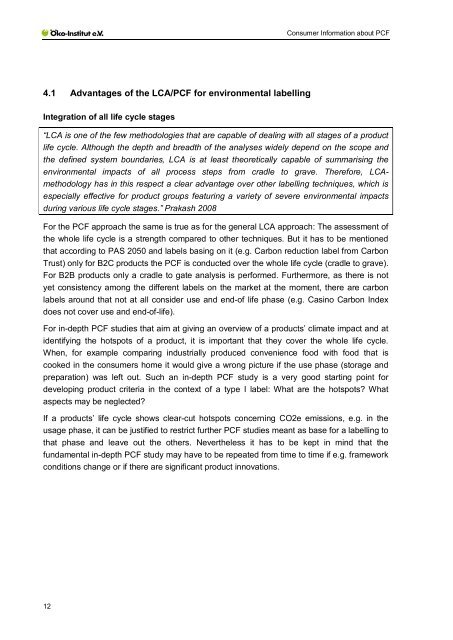Requirements on Consumer Information about Product ... - ANEC
Requirements on Consumer Information about Product ... - ANEC
Requirements on Consumer Information about Product ... - ANEC
You also want an ePaper? Increase the reach of your titles
YUMPU automatically turns print PDFs into web optimized ePapers that Google loves.
C<strong>on</strong>sumer Informati<strong>on</strong> <strong>about</strong> PCF<br />
4.1 Advantages of the LCA/PCF for envir<strong>on</strong>mental labelling<br />
Integrati<strong>on</strong> of all life cycle stages<br />
“LCA is <strong>on</strong>e of the few methodologies that are capable of dealing with all stages of a product<br />
life cycle. Although the depth and breadth of the analyses widely depend <strong>on</strong> the scope and<br />
the defined system boundaries, LCA is at least theoretically capable of summarising the<br />
envir<strong>on</strong>mental impacts of all process steps from cradle to grave. Therefore, LCAmethodology<br />
has in this respect a clear advantage over other labelling techniques, which is<br />
especially effective for product groups featuring a variety of severe envir<strong>on</strong>mental impacts<br />
during various life cycle stages.” Prakash 2008<br />
For the PCF approach the same is true as for the general LCA approach: The assessment of<br />
the whole life cycle is a strength compared to other techniques. But it has to be menti<strong>on</strong>ed<br />
that according to PAS 2050 and labels basing <strong>on</strong> it (e.g. Carb<strong>on</strong> reducti<strong>on</strong> label from Carb<strong>on</strong><br />
Trust) <strong>on</strong>ly for B2C products the PCF is c<strong>on</strong>ducted over the whole life cycle (cradle to grave).<br />
For B2B products <strong>on</strong>ly a cradle to gate analysis is performed. Furthermore, as there is not<br />
yet c<strong>on</strong>sistency am<strong>on</strong>g the different labels <strong>on</strong> the market at the moment, there are carb<strong>on</strong><br />
labels around that not at all c<strong>on</strong>sider use and end-of life phase (e.g. Casino Carb<strong>on</strong> Index<br />
does not cover use and end-of-life).<br />
For in-depth PCF studies that aim at giving an overview of a products’ climate impact and at<br />
identifying the hotspots of a product, it is important that they cover the whole life cycle.<br />
When, for example comparing industrially produced c<strong>on</strong>venience food with food that is<br />
cooked in the c<strong>on</strong>sumers home it would give a wr<strong>on</strong>g picture if the use phase (storage and<br />
preparati<strong>on</strong>) was left out. Such an in-depth PCF study is a very good starting point for<br />
developing product criteria in the c<strong>on</strong>text of a type I label: What are the hotspots? What<br />
aspects may be neglected?<br />
If a products’ life cycle shows clear-cut hotspots c<strong>on</strong>cerning CO2e emissi<strong>on</strong>s, e.g. in the<br />
usage phase, it can be justified to restrict further PCF studies meant as base for a labelling to<br />
that phase and leave out the others. Nevertheless it has to be kept in mind that the<br />
fundamental in-depth PCF study may have to be repeated from time to time if e.g. framework<br />
c<strong>on</strong>diti<strong>on</strong>s change or if there are significant product innovati<strong>on</strong>s.<br />
12
















